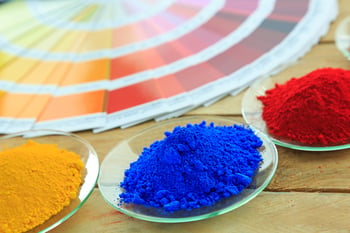 Polyvinylidene Fluoride, or PVDF, is a type of thermoplastic fluoropolymer characterized by its low density, high temperature resistance (for a plastic), and low thermal conductivity. Like many other fluoropolymers, PVDF is chemically inert when exposed to most solvents—although PVDF can resist a few things that some other fluoropolymers cannot.
Polyvinylidene Fluoride, or PVDF, is a type of thermoplastic fluoropolymer characterized by its low density, high temperature resistance (for a plastic), and low thermal conductivity. Like many other fluoropolymers, PVDF is chemically inert when exposed to most solvents—although PVDF can resist a few things that some other fluoropolymers cannot.
Some advantages of using PVDF coatings for stainless steel wire forms over other common fluoropolymer coatings include:
Heat Resistance
PVDF is a material that can retain the majority of its strength at temperatures up to 280°F. For comparison, polyvinyl chloride (PVC) has a maximum service temperature of just 140°F.
While 280°F is not so much that PVDF can be safely used in oven-like conditions, it is high enough to withstand many high-temp sanitation processes designed to sterilize surfaces by increasing temperatures to 165°F. This alone allows PVDF to be used for many applications that would melt other materials.
Chemical Resistance
It’s not uncommon for fluoropolymers to be highly resistant to acids and alkalis. However, these chemical resistances aren’t typically absolute.
For example, PVC is susceptible to attack by ketones, some chlorinated hydrocarbons, and aromatics. Polypropylene is susceptible to oxidizing acids, chlorinated hydrocarbons, and aromatics.
PVDF, on the other hand, is resistant to most acids, bases, organic solvents, chlorine, bromine, and other halogen compounds.
Tensile Strength
PVDF has a tensile strength of around 50 MPa (7,251 psi). This makes the material fairly strong compared to most other fluoropolymers. For example, polypropylene has a tensile strength of 33 MPa (4,800 psi).
In other words, PVDF can take roughly 1.5 times the load of polypropylene without failing.
Surface Hardness
PVDF has a surface hardness on the Rockwell Hardness “R” scale of roughly 100. This puts the material on the high end of semi-rigid coatings—being just slightly harder than polypropylene. This makes the material just flexible enough to absorb impacts, but hard enough to prevent it from being easily scraped away through everyday abrasion—such as what occurs when baskets are moved via conveyors or handled manually with rough hands/gloves.
Ultraviolet Light Resistance
Some coating materials, such as polyethylene, have a particular weakness to exposure to ultraviolet (UV) radiation. In direct sunlight, the UV radiation from the sun will break down the chemical bonds of the polymer, weakening the material and potentially leading to decay.
However, PVDF does not possess this particular weakness. The material is resistant to UV radiation, making it useful for coating baskets that may be stored or used outdoor areas.
Should You Use PVDF for Your Next Custom Wire Basket?
PVDF isn’t the best material at resisting all chemicals, nor does it have the highest tensile strength of any fluoropolymer. Some coatings, such as Teflon®, also have higher temperature resistances. However, what PVDF does possess is one of the best balances of strength, chemical resistance, and temperature tolerance of any coating available.
PVDF may be the ideal material for your application if you need a well-rounded coating that combines strength and resistance to chemical attack in a process that doesn’t exceed 280°F. Of course, it doesn’t hurt to investigate your other coating options before settling on a solution—or to seek expert advice from a degreed mechanical engineer with years of experience in creating custom wire baskets with a variety of coating materials.



.gif)


